A uniform horizontal rod of mass 2.1 kg and
length 0.25 m is free to pivot about one end
...

Physics, 30.05.2020 05:00, yasminothman02
A uniform horizontal rod of mass 2.1 kg and
length 0.25 m is free to pivot about one end
as shown. The moment of inertia of the rod
about an axis perpendicular to the rod and
through the center of mass is given by I =
m ℓ^2 /2. If a 9.6 N force at an angle of 78◦
to the horizontal acts on the rod as shown, what is the
magnitude of the resulting angular acceleration about the pivot point? The acceleration
of gravity is 9.8 m/s^2
Answer in units of rad/s^2
Picture for more info


Answers: 1
Other questions on the subject: Physics



Physics, 22.06.2019 02:30, coltonstevens15
Which feature of a heating curve indicates a change ofn state
Answers: 1

Physics, 22.06.2019 10:00, amyaacrawford86
Because air contracts as it cools, the air pressure inside a freezer is typically lower than on the outside. why do ice cubes inside a freezer tend to shrink over time? a. the ice dissolves oxygen from the air, forming a denser crystalline matrix. b. the ice reacts chemically with carbon dioxide in the air, forming gaseous carbon compounds. c. the ice melts, and then the liquid freezes as ice crystals on the bottom of the freezer. d. the ice sublimes, and then the water vapor deposits as ice crystals on the sides of the freezer.
Answers: 1
Do you know the correct answer?
Questions in other subjects:



Mathematics, 04.02.2020 20:47



Mathematics, 04.02.2020 20:47

Computers and Technology, 04.02.2020 20:47

Mathematics, 04.02.2020 20:47









